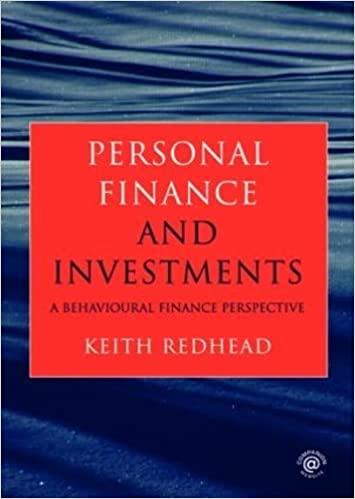Question
1. Consider a project with free cash flows in one year of $130,000 or $180,000, with each outcome being equally likely. The initial investment required
1. Consider a project with free cash flows in one year of $130,000 or $180,000, with each outcome being equally likely. The initial investment required for the project is $100,000, and the projects cost of capital is 20%. a. Suppose that to raise the funds for the initial investment, the project is sold to investors as an all-equity firm. The equity holders will receive the cash flows of the project in one year. How much money can be raised in this waythat is, what is the initial market value of the unlevered equity? b. Suppose the initial $100,000 is instead raised by borrowing at the risk-free interest rate. The risk-free interest rate is 10%. What are the cash flows of the levered equity, and what is its initial value according to MM?
2. Investors are willing to provide you with $2 million in initial capital in exchange for 50% of the unlevered equity in the firm. What is the total market value of the firm without leverage? Suppose you borrow $1 million. According to MM, what fraction of the firms equity will you need to sell to raise the additional $1 million you need? [Hint: its not 25%]
3. Acort Industries owns assets that will have an 80% probability of having a market value of $50 million in one year. There is a 20% chance that the assets will be worth only $20 million. Acorts assets have a cost of capital of 10%. a. If Acort is unlevered, what is the current market value of its equity? b. Suppose instead that Acort has debt with a face value of $20 million due in one year. The current riskfree rate is 5%. According to MM, what is the value of Acorts equity in this case? c. What is the expected return of Acorts equity without leverage? What is the expected return of Acorts equity with leverage?
4. Suppose Alpha Industries and Omega Technology have identical assets that generate identical cash flows. Alpha Industries is an all-equity firm, with 10 million shares outstanding that trade for a price of $22 per share. Omega Technology has 20 million shares outstanding as well as debt of $60 million. a. According to MM Proposition I, what is the stock pric e for Omega Technology?
5. Explain what is wrong with the following argument: If a firm issues debt that is risk free, because there is no possibility of default, the risk of the firms equity does not change. Therefore, risk-free debt allows the firm to get the benefit of a low cost of capital of debt without raising its cost of capital of equity.
6. Suppose the Washington Post Company (WPO) has no debt and an equity cost of capital of 9.2%. The average debt-to-value ratio for the publishing industry is 13%. What would its cost of equity be if it took on the average amount of debt for its industry at a cost of debt of 6%?
Step by Step Solution
There are 3 Steps involved in it
Step: 1

Get Instant Access to Expert-Tailored Solutions
See step-by-step solutions with expert insights and AI powered tools for academic success
Step: 2

Step: 3

Ace Your Homework with AI
Get the answers you need in no time with our AI-driven, step-by-step assistance
Get Started


